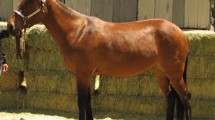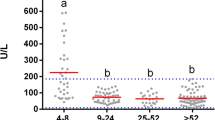Abstract
In the current study, we aimed to establish reference values for the most important clinical, hematobiochemical and electrocardiographic (ECG) parameters and evaluate the effect of sex, age and season in miniature donkey. We hypothesized that these parameters in this valuable breed of donkey would be different from those of other species of equidae. Twenty apparently healthy miniature donkeys aged 1–8 years and weighing averagely 115 ± 10 kg, with an average height of 0.83 ± 0.3 m, were used in this study. Based on sex, age and season of sampling, the animals were divided into groups. Animals less than 2 years old, between 2 and 5 years old and those over 5 years of age were considered foal, young and adult, respectively. The ECG was attached as a bipolar base-apex lead and indices measured and analyzed were P, QRS and T wave amplitude and duration and duration of PR, QT and RR intervals. Red blood cell (RBC), white blood cell (WBC) and WBC differential counts were performed using a hemacytometer. Sera were collected for measurement of sodium (Na+), potassium (K+), chloride (Cl−), calcium (Ca2+), magnesium (Mg2+) and phosphorus (P−) concentrations. Heart rate (HR), PR and RR intervals were different from reference ranges. Male and female animals showed no significant differences in clinical, hematobiochemical and ECG parameters except in serum concentrations of Ca2+ and Mg2+ (P < 0.05). There were significant differences in HR, RR interval and serum level of P− and Na+ among age groups. Eosinophil in autumn was significantly higher than that in spring (P < 0.05). The configuration of P and T waves was mainly biphasic and monophasic, respectively. The majority of ECGs was of the QS configuration. Differences between sexes and seasons and among age groups were insignificant (P > 0.05). The data obtained in the present study are the first reference values to be published for the miniature donkey and can be useful in our understanding of this breed’s normal parameters, which will help veterinarians to appropriately interpret laboratory data. Results of the present study can be used for monitoring the health status, diagnosing the diseases and improving the management and conservation strategies of this breed.
Similar content being viewed by others
References
Al Shafei NK, Ahmad SM, Ibrahim AM (2015) Some sero-biochemical reference values of working donkeys (Equus asinus) from the Sudan. Biochem Anal Biochem 4:4–7
Azab ME, Abdel-Maksoud HA (1999) Changes in some hematological and biochemical parameters during prepartum and postpartum periods in female Baladi goats. Small Rum Res 34:77–85
Burden FA, Hazell-Smith E, Mulugeta G, Patrick V, Trawford R, Brooks Brownlie HW (2016) Reference intervals for biochemical and haematological parameters in mature domestic donkeys (Equus asinus) in the UK. Equine Vet Educ 28:134–139
Cebra C, Cebra M (2002) Diseases of the cardiovascular system. In: Sheep and goat medicine, 1st edn. WB Saunders, Philadelphia, USA, pp 393–396
Daramola J, Adeloye A, Fatoba T, Soladoye A (2005) Haematological and biochemical parameters of West African Dwarf goat. Livestock Res Rural Dev 17:3–4
Escudero A, Gonzalez JR, Benedito JL, Prieto FR, Ayala I (2009) Electrocardiographic parameters in the clinically healthy Zamorano-Leones donkey. Res Vet Sci 87:458–461
Folgh P, Jordana J, Cuenca R (1997) Reference ranges and the influence of age and sex on hematological values of the endangered Catalonian donkey. Vet J 154:163–168
French JN, Patrick HV (1995) Reference values for physiological, haematological and biochemical parameters in domestic donkeys (Equus asinus). Equine Vet Educ 7:33–35
Gasek F, Bizzuti O, Ferri RG, Perdigao de Oliveira FR (1977) Evolution of blood serum globulins as determined by pregnancy in the domestic donkey (Equus asinus). Br Vet J 133:548–553
Girardi AM, Marques LC, de Toledo CZP, de Compos FE (2015) Hematological variables of the Pêga donkey (Equus asinus) breed: influence of age and sex. Comp Clin Pathol 24:335–342
Guccione J, Piantedosi D, Di Loria A, Veneziano V, Ciaramella P (2014) Long-term electrocardiography recording with Holter monitoring in 15 donkeys. J Equine Vet Sci 34:302–306
Gul ST, Ahmad M, Khan A, Hussain I (2007) Haemato-biochemical observations in apparently healthy equine species. Pak Vet J 27:155–158
Hawkey CM, Ashton DG, Hart MG, Cindery RN, Jones DM (1983) Normal and clinical haematology in the yak (Bos grunniens). Res Vet Sci 34:31–36
Jordana J, Folch P, Cuenca R (1998) Clinical biochemical parameters of the endangered Catalonian donkey breed: normal values and the influence of sex, age and management practices effect. Res Vet Sci 64:7–10
Kojouri GA, Rezakhani A, Torki E (2007) The effects of verapamil hydrochloride on electrocardiographic (ECG) parameters of domestic donkey (Equus asinus). J Equine Vet Sci 27:499–503
Latimer KS, Mahaffey EA, Prasse KW (2003) Duncan and Prasse’ veterinary laboratory medicine, 4th edn. Blackwell, Oxford, pp 3–45
Lopez I, Estepa JC, Mendoza FJ, Rodriguez M, Aguilera-Tejero E (2006) Serum concentrations of calcium, phosphorus, magnesium and calciotropic hormones in donkeys. Am J Vet Res 67:1333–1336
Mbassa GK, Poulsen JSD (1992) The comparative haematology of cross-bred and indigenous east African goats of Tanzania and breeds reared in Denmark. Vet Res Commun 16:221–229
Mozaffari AA, Derakhshanfar A, Alinejad A, Morovati M (2010) A comparative study on the adverse effects of flunixin, ketoprofen and phenylbutazone in miniature donkeys: haematological, biochemical and pathological findings. N Z Vet J 58:224–228
Muylle S, Simoens P, Lauwers H, Van Loon G (1999) Age determination in mini-Shetland ponies and donkeys. J Vet Med 46:421–429
Opara M, Udevi N, Okoli I (2010) Haematological parameters and blood chemistry of apparently healthy West African Dwarf (Wad) goats in Owerri, South Eastern Nigeria. NY Sci J 3:68–72
Physick-Sheard PW, Hendren CM (1983) Heart score: physiological basis and confounding variables. Equine Vet J 12:81–84
Pospisil J, Kase F (1984) Basic haematological values in antelopes—IV. A comparison and concluding remarks. Comp Biochem Physiol A Comp Physiol 78:815–821
Qureshi AS, Ali M (2016) Serum enzyme activities and electrolyte concentrations of breeding donkeys (Equus asinus): effect of sex, age, lactation and/or pregnancy. J Anim Plant Sci 26:88–92
Radostits OM, Gay CC, Hinchcliff KW, Constable PD (2007) Veterinary medicine: a textbook of the diseases of cattle, horses, sheep, pigs and goats, 10th edn. Elsevier, London, pp 399–438
Rezakhani A, Szabuniewicz M (1977) The electrocardiogram of the camel (Camelus dromedarius). Zbl Vet Med A 24:277–286
Rezakhani A, Yazdanmehr MM (1977) The normal electrocardiographic parameters of the domestic donkey (Equus asinus). Zbl Vet Med A 24:672–679
Rezakhani A, Papahn AA, Shekarfroush S (2004) Analysis of base apex lead electrocardiograms of normal dairy cows. Vet Arhiv 74:351–358
Roubies N, Panousis N, Fytianou A, Katsoulos P, Giadinis N, Karatzias H (2006) Effects of age and reproductive stage on certain serum biochemical parameters of Chios sheep under Greek rearing conditions. J Vet Med A 53:277–281
Santamarina G, Espino L, Suarez ML (2001) Electrocardiographic parameters of free-ranging roe deer (Capreolus capreolus). J Zoo Wildl Med 32:441–446
Sgorbini M, Bonelli F, Rota A, Baragli P, Marchetti V, Corazza M (2013) Hematology and clinical chemistry in Amiata donkey foals from birth to 2 months of age. J Equine Vet Sci 33:35–39
Shamsaddini Bafti M, Mozaffari AA (2012) Normal hematological parameters in Iranian cashmere (Raini) goats. Comp Clin Pathol 21:1653–1655
Simenew K, Gezahegne M, Getachew M, Wondyefraw M, Alemayehu L, Eyob I (2011) Reference value of clinically important physiological, hematological and serum biochemical parameters of apparently healthy working equids of Ethiopia. Glob Vet 7:1–6
Smith BP (2015) Large animal internal medicine, 5th edn. Mosby, St. Louis, pp 2020–2024
Sow A, Kalandi KM, Ndiaye NP, Bathily A, Sawadogo GJ (2012) Clinical biochemical parameters of Burkinabese local donkeys’ breeds. Int Res J Biochem Bioinform 2:84–89
Stanišić L, Dimitrijević V, Simeunović P, Lakić N, Radović I, Ivanković A, Stevanović J, Stanimirović Z (2015) Morphological, biochemical and hematological characterization of endangered Balkan donkey breed. Acta Vet-Beograd 65:125–136
Tajik J, Samimi AS, Shojaeepour S, Jarakani S (2016) Analysis of base-apex lead electrocardiogram in clinically healthy Kermani sheep. J Fac Vet Med Istanbul Univ 42:74–79
Tharwat M, Al-Sobayil F (2014) Influence of the cardiac glycoside digoxin on cardiac troponin I, acid–base and electrolyte balance, and haematobiochemical profiles in healthy donkeys (Equus asinus). Vet Res 10:64–70
Zakari FO, Ayo JO, Rekwot PI, Kawu MU (2016) Effect of age, sex, physical activity and meteorological factors on haematological parameters of donkeys (Equus asinus). Comp Clin Pathol 25:1265–1272
Zinkle JG, Mae D, Guzman Merida P, Farver TB, Humble JA (1990) Reference ranges and the influence of age and sex on hematologic and serum biochemical values in donkeys (Equus asinus). Am J Vet Res 51:408–413
Author information
Authors and Affiliations
Corresponding author
Ethics declarations
Conflict of interest
The authors declare that they have no competing interests.
Ethical approval
All applicable national, international and/or institutional guidelines for the care and use of animals were followed.
Rights and permissions
About this article
Cite this article
Samimi, A.S., Tajik, J. Reference values for some clinical, hematobiochemical and electrocardiographic parameters in miniature donkeys: the effect of sex, age and season. Comp Clin Pathol 26, 1075–1081 (2017). https://doi.org/10.1007/s00580-017-2488-1
Received:
Accepted:
Published:
Issue Date:
DOI: https://doi.org/10.1007/s00580-017-2488-1




